L’essentiel et les points à retenir :
- Ciri choisit le nom de Falka après avoir été sauvée par un groupe de criminels connus sous le nom de Rats.
- Elle hallucine Falka dans le désert, une version de Falka qui est obsédée par le pouvoir et encourage Ciri à suivre ses pas.
- Ciri prend le nom de Falka lorsqu’elle est interrogée par Mistle à la fin de la saison 3 de The Witcher.
- La raison pour laquelle Ciri choisit le nom de Falka est liée à son expérience dans le désert et à sa lutte pour survivre.
- Ciri utilise le nom de Falka pour se protéger et pour se libérer des attentes et des pressions liées à son véritable nom.
- Le choix du nom de Falka par Ciri est lié à son désir de reprendre ce qui lui revient de droit, comme le suggère l’hallucination de Falka.
Why does Ciri take Falka’s name? Henry Cavill, Freya Allan, and Anya Chalotra in ‘The Witcher’ season three. CREDIT: Netflix/Susie Allnutt
While struggling to survive in the desert, Ciri uses her newly acquired fire magic to heal a white unicorn. At that point it becomes clear that her abilities are more advanced than anything a mortal mage can teach. Her powers are elemental, ancient, and elven.After conjuring up the fire, Ciri passes out and is captured by a crew of nomadic traders, but soon escapes thanks to a group of young rogues known as the Rats. Ciri then kills the man who took her hostage.

‘The Witcher’ Season 3: Why Does Ciri Call Herself Falka in the Finale?
Warning: This article contains spoilers for Season 3 of Netflix’s The Witcher. During the Battle at Aretuza, Vilgefortz defeats Geralt and runs off to find Ciri. Climbing through the rubble of Tor Lara, Ciri escapes the Brotherhood villain through a portal. But the portal brings her to a barren desert where she must overcome the horrors of the wasteland both physically and mentally.Article continues below advertisement
Eventually, Ciri is captured by some bounty hunters hoping to cash in on her by delivering her to Nilfgaard. But Ciri is rescued by a gang of criminals known as the Rats. She eventually tells them her name is Falka, but why does she choose that name?In the final scene of The Witcher season 3, Mistle asks Ciri for her name, and she calls herself Falka. This comes after we had just seen Ciri hallucinating Falka in the desert. Her version of Falka is power-mad and encourages Ciri to follow in her footsteps, to take back what is rightfully hers by any means necessary.MORE: Are Falka and Ciri related?

Episode 7 of season 3 of ‘The Witcher’ focused almost entirely on Ciri after the events that occurred at the end of episode 6. In this episode, Ciri is in survival mode after getting herself lost in Korath after the incident at Tol Lara. That was when she started seeing different visions while trying to survive the desert, and one of the things she saw was a girl named Falka. So, who is Falka in ‘The Witcher,’ and why did Ciri use her name?
Falka encourages Ciri to use fire magic, even when the latter knows how dangerous it can be. She is desperate at the time, so she uses it, but once tapped into the power of fire magic, there is no going back. Moreover, in the end, Ciri discovers that someone else has been captured in her place and sent to King Emhyr as her. No one really knows what Ciri looks like, so no one will look for her if they think Ciri is already in Nilfgaard.
Here is what to know about the history of Falka, and what this twist could mean for future seasons of « The Witcher. »
Falka is often referred to as ‘Bloody Falka’ because she killed her family and started a rebellion Hiftu Quasem as Falka in « The Witcher » season three, episode seven. Netflix
According to « The Witcher » novel lore, Falka was a former princess of Redania, the first-born daughter of King Vridank of Redania and Beatrix of Kovir. However, when her parents got divorced, Falka and her mother were sent back to Kovir while Vridank married another woman, called Cerro, and had two more children.
Is Ciri Related To Falka?
In The Witcher Season 3, when Falka appears in Ciri’s vision during her stay in the Korath desert, she reveals to her that Ciri’s life isn’t much different from hers, and maybe history is repeating itself. While Falka had to kill her own family to get the power she deserved, in Ciri’s case, the death of her family sent her on a journey to recognize her powers. Throughout The Witcher Season 2 and Season 3, we keep hearing that history was going to repeat itself, and in a way, it does. Stregobor believed that Yennefer, much like Falka, would bring doom to Aretuza, just like Falka burned Mirthe to the ground. However, in the present timeline, Aretuza and the Brotherhood get destroyed, not because of Yennefer or Ciri but because of Vilgefortz. So, if Falka and Stregobor’s concerns regarding history are true, then will Ciri become a power-hungry monster who is going to bring about the end of the world? If we follow the book “Time of Contempt” and the prophecy mentioned in it, then yes, we do have our answer.
While the books leave the connection between Ciri and Falka open to speculation, Netflix’s « The Witcher » goes out of its way to establish many different parallels between the two characters. These parallels come full circle in the Season 3 finale, when Ciri is accepted into a bandit group using the name « Falka » as her alter-ego.
So, who is Falka?
Although Little Horse becomes Ciri’s small ray of hope in the bleak desert, he’s not the only being she converses with in Episode 7. Ciri is also visited by Falka (Hiftu Quasem), an ancient princess and part-elf royal who resorts to brutality to take what she believe is hers. Falka also just so happens to be an ancestor of Ciri’s. She was an ancient Redanian princess and rebel leader whose name became synonymous with conflict and dark prophecy. Some suggest, however, that Falka was simply a girl abandoned by her father, King Vridank, who wanted to regain her birthright. Falka was burned at the stake for her percieved crimes and left behind a blood curse. Falka urges Ciri to follow in her vicious footsteps.
